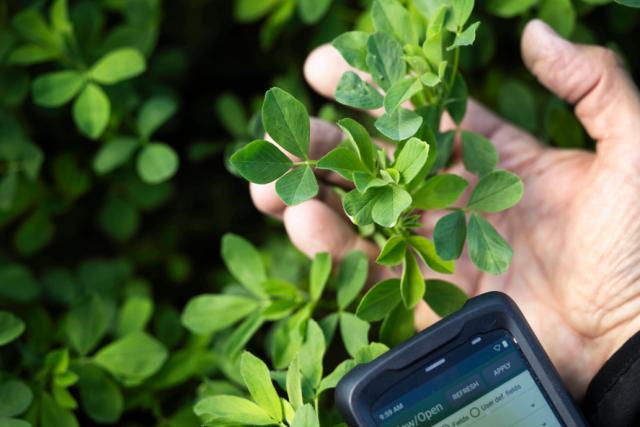RESEARCH & DEVELOPMENT DRIVES INNOVATION AT DLF
DLF is continuously developing new products and implementing new technologies that contribute to a more sustainable future for our customers and planet. See the topics below to learn more.

Genomic Selection
Genomic selection speeds up the detection of plant material with high potential for improvement. For over a decade, DLF researchers have aligned our observational data with the DNA of the plant material to learn which parts of a plant genome control different traits. Once an association is established, we can calculate which plants will have the highest breeding value for a particular trait. As more and more data from breeding lines are applied to the underlying model, the value and precision of the selection criteria increases.

Root Screening
DLF developed the world’s most advanced root-screening facility, RadiMax, in collaboration with Danish universities and breeding companies. The state-of-the-art system enables multispectral imaging of roots three meters into the soil while grasses above ground are subjected to varying degrees of stress through a controlled soil moisture gradient. Advanced root-screening helps us select plant varieties with improved drought tolerance, quicker establishment, better uptake of nutrients, and a greater storage capacity for carbon.

Precision Data Collection
DLF researchers use aerial drones to collect data for certain traits and utilize machine-learning models to precisely discern genetic differences in trial plots. Most of our harvesters are also equipped with near-infrared reflectance spectroscopy (NIRS), which provides real-time, point-of-cropping data on biological material composition and quality.

Novel Endophytes
Novel endophytes have been widely used to help improve insect tolerance, stress tolerance and persistency in turfgrasses. With the help of molecular marker technology, our researchers can now identify endophytes that enhance forages and are safe for animals. They field test the inoculated host genotypes and confirm the absence of ergo-alkaloids through lab analysis and animal feeding studies.

Festulolium
Crossing fescues with ryegrasses resulted in a new set of forage grasses called Festuloliums that utilize the best traits of each species. DLF is the global leader in festulolium R&D and specializes in two species, Festulolium braunii (meadow fescue crossed with Italian ryegrass) and Festulolium pabulare (tall fescue crossed with Italian ryegrass). Depending on the combination selected, end users benefit from a higher-yielding fescue with improved forage quality, or a higher-yielding ryegrass with improved persistency.

Microclover
Microclover is a truly sustainable solution for turf mixes. The unique small-leaved white clover produces its own nitrogen through a continuous process of roots dying and degenerating, and the accumulated nitrogen it produces is shared with surrounding plants. Microclover also has a special ability to grow between plants, which keeps turf dense and prevents weeds from establishing. Additionally, it tolerates a range of climatic and soil conditions (wet, shade, drought) and recovers quickly after severe stress.

Alfalfa Germplasm
DLF alfalfa breeders work with the most diverse germplasm in the industry. Our multiple genetic pools contain all the traits needed to create a world class alfalfa seed product. Sophisticated data collection, analysis and selection methods allow us to make significant gains year after year for key traits like disease resistance, digestibility, standability, regrowth, persistency and forage yield.

Turf Tetraploid
The advancement of tetraploid perennial ryegrass (turf plants with twice the number of chromosomes) has resulted in deeper root systems that contain more energy reserves for rapid establishment, germination in cold soil temperatures, quicker recovery, and enhanced protection against drought and turf diseases.
-Sheep-Fescue__DLF_Gradient.jpg&width=640&format=webp&quality=99)
Fiber Energy
Through plant breeding, screening and lab analysis, DLF researchers can select varieties with higher levels of digestible neutral detergent fiber (dNDF), which we refer to as Fiber Energy. Researchers target the wall of a plant cell, specifically cellulose and hemicellulose, because the other parts of a plant cell are nearly 100% digestible and thus offer very little room for improvement. The work has resulted in significant improvements to milk yield and livestock weight gain around the world. On average, DLF researchers estimate a 1% increase in cell wall digestibility results in an extra 0.25 liters of milk per cow per day and 24 more grams of live weight gain per day for livestock animals.

Super Bents
DLF built a world-class creeping bentgrass breeding program by listening to and partnering with golf course superintendents. For decades, end user insight has guided our research, helping to ensure the traits we evaluate lead to significant improvements in bentgrass cultivars for greens and fairways. Our meticulous selection and testing program produces the most advanced and environmentally friendly bentgrass varieties in the world.